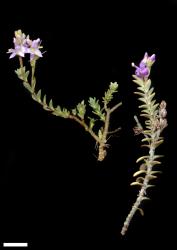- ≡ Hebe pimeleoides var. rupestris Cockayne & Allan, Trans. New Zealand Inst. 57: 39 (1926) nom. illeg.
- ≡ Hebe pimeleoides (Hook.f.) Cockayne & Allan, Trans. New Zealand Inst. 57: 38 (1926)
- = Veronica glauca-caerulea J.B.Armstr., N.Z. Ctry. J. 3: 57 (1879)
- ≡ Veronica pimeleoides var. glauca-caerulea (J.B.Armstr.) Cheeseman, Man. New Zealand Fl. 527 (1906)
- ≡ Hebe pimeleoides var. glauco-caerulea (J.B.Armstr.) Cockayne et Allan, Trans. New Zealand Inst. 57: 38 (1926)
- ≡ Hebe glauca-caerulea (J.B.Armstr.) Cockayne, Trans. New Zealand Inst. 60: 471 (1929)
Low sub-shrub or small, bushy shrub to 0.9 m tall. Stems prostrate to erect, eglandular-pubescent or glabrous; hairs bifarious to uniform. Leaf bud distinct, its leaves appressed at margins until fully grown; sinus absent or small, narrow, and acute. Leaves opposite-decussate, erecto-patent to spreading; lamina sub-coriaceous to coriaceous, linear-elliptic to lanceolate to ovate or elliptic to sub-orbicular, 2.0–15.5 mm long, 0.7–8.7 mm long, dull, glaucous above and beneath, sometimes red-mottled; veins not evident or midrib slightly raised beneath; surfaces glabrous or sometimes one or both pubescent; margin glabrous or rarely minutely ciliolate, entire; apex acute to sub-acute or rarely obtuse; base cuneate; petiole absent or indistinct, 0–1 mm long. Inflorescence a lateral spike or raceme, 8–70 mm long; flowers crowded, 4–24, all bisexual; bracts opposite-decussate, sometimes becoming alternate above, linear to ovate or elliptic, > pedicels; pedicels absent or < 1 mm long, rarely to 4.5 mm, eglandular-hairy all around. Calyx lobes 4, acute to acuminate, 2–5 mm long, sub-equal, eglandular-ciliolate or -ciliate, rarely eglandular-hairy. Corolla 6–10 mm diameter; tube white to purplish, 1.0–2.5 mm long, < calyx, glabrous; lobes 4, purplish to blue, fading to pink or white, erecto-patent to recurved, unequal to sub-equal, lanceolate, ovate, elliptic, or obovate, 2.5–5.0 mm long, acute to sub-acute, rarely rounded; nectar guides absent. Stamen filaments pale purple fading white, 3–4 mm long; anthers pink, purplish, or magenta. Style glabrous or eglandular-hairy, 2.0–4.5 mm long. Capsules latiseptate, usually sub-acute or sometimes acute or obtuse, glabrous or eglandular-pubescent, 3.5–5.0 mm long, 2.2–3.2 mm at widest point. Seeds ellipsoid or broadly ellipsoid, flattened, smooth, pale brown, 0.8–1.3 mm.
| 1 | Stems mat-forming or creeping to decumbent, to 0.3 m tall; leaves 2.0–12.1 × 0.7–5.2 mm; flowers mauve, blue, or violet, 6–8 mm diameter | subsp. pimeleoides |
| Stems ascending to erect, to 0.9 m tall; leaves 7.5–15.5 × 1.8–8.7 mm; flowers mauve, fading white, 8–10 mm diameter | subsp. faucicola |
Veronica pimeleoides plants can be distinguished from other glaucous-leaved hebes by their small, often narrow leaves (although they may be sub-orbicular), usually coloured flowers, and often acute to acuminate calyx and corolla lobes. The contrast between the glaucous leaves and the dark stems is also distinctive.
V. biggarii plants are similar, with small, glaucous leaves, but usually sparsely puberulent stems and inflorescences, leaves are thicker, often reddish, and blunt at the apex, bracts are alternate throughout, pedicels 1–3 mm long, and the flowers have white corollas.
South Island: Marlborough, Canterbury, Otago; mostly in the west.
Grasslands, terraces, lake shores, rock outcrops.
| Category | Number |
|---|---|
| Indigenous (Endemic) | 2 |
| Total | 2 |
Flowers: December–March; fruits: January–May (persisting all year).
2n = 40, 80 (See Bayly & Kellow 2006, as Hebe pimeleoides).
Veronica pimeleoides is classified in V. subg. Pseudoveronica sect. Hebe and the informal group “Subcarnosae” (Albach & Meudt 2010; Bayly & Kellow 2006).




